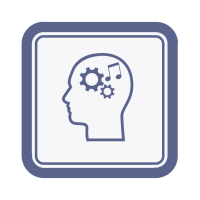Have you wished you could sing but never known where to start? Or perhaps you’ve spent hours singing songs you love and wondered why you never seem to improve – or why other people don’t seem to think you sound so good. Today we’re sharing a new guide that can help you become a great singer, step by step.
Here at Easy Ear Training we firmly believe that every musician can and should learn to sing. Whether or not you ever intend to take the stage with microphone in hand, you owe it to yourself to be able to sing clearly and confidently in tune.
In support of this we’ve published a number of tutorials and created products to help people learn to sing including the popular Tone Deaf Test and SingTrue app.
Over the last few months we’ve been gradually adding our very best singing training material to our flagship training site, Musical U and this week we finally unveiled our full guide for aspiring singers: the Learn to Sing Roadmap.

This is the “big picture” guide for learning to sing which takes you from zero ability to knowing confidently that you can reliably sing in tune and sound good.
→ See the full Learn to Sing Roadmap
What is a “Roadmap”?
 At Musical U we provide a fully-flexible training system which lets you create a personalised plan to suit your musical needs and goals. The team is always available to offer advice and guidance but we also have a set of Roadmaps which can help you see the next steps to take in your musical development.
At Musical U we provide a fully-flexible training system which lets you create a personalised plan to suit your musical needs and goals. The team is always available to offer advice and guidance but we also have a set of Roadmaps which can help you see the next steps to take in your musical development.
Each Roadmap is designed to answer these three questions:
- Where am I?
- Where do I want to go?
- How will I get there?
Once you’ve read through the Roadmap (including the free preview linked below) you will know your answer to each of these three questions, letting you go ahead and create your ideal personal training plan.
→ Learn more about ear training roadmaps
A Roadmap for Learning to Sing
Many self-taught singers try to become better simply by singing. They sing more songs, new songs, harder songs, again and again, hoping to improve over time.
This is a natural approach to choose but it’s a bit like trying to become a good tennis player by simply playing tennis every day. It does work, but improvement is slow and ultimately you won’t become as good as if you actually take the time to practice the skills of the game. In tennis you learn to hold the racket, how to hit forehand and backhand, how to serve, and so on. Your tennis game improves as you improve the fundamental skills of being a tennis player.
At Musical U we take this kind of skills-based approach to learning to sing.
Instead of just presenting you with a series of songs to practice, we teach each of the component skills of singing and help you to gradually build up your ability. The Roadmap takes you from “I can’t sing” through learning to sing a single note accurately in tune, developing control of your vocal pitch, assessing the quality of your voice based on the key factors that make a singer sound “good”, and then working on exercises to improve your voice and build your confidence as a singer.
Along the way you will, of course, sing songs but it is the intentional practice of key skills which will allow you to quickly become a confident and capable singer.
Phase 1: Singing Fundamentals
In the first phase of the Roadmap we’ll tackle the most fundamental part of singing: your sense of pitch.
First you’ll check for certain that you aren’t “tone deaf” using a simple test. Then you’ll learn all about the power and subtlety of musical pitch in the Ear Expansion: Pitch module.
Then it’s time to start applying this to your singing voice by learning the core skill of matching pitch, meaning that when you hear a note you are able to sing back that same note, accurately in tune.
A set of exercises let you practice matching pitch until you can reliably produce the pitch you intend to every time you open your mouth to sing.
All Musical U members get access to the full set of Easy Ear Training iOS apps as part of their membership, so if you happen to have an iPhone or iPad you can also train in this phase using the interactive SingTrue app.
By the end of this phase you will be able to reliably and easily match pitch with your singing voice.
Phase 2: Get Control
With single notes mastered it’s time to tackle moving between notes. The Vocal Control module explains what allows you to control your singing pitch and provides exercises you can use to start exploring your singing range.
 In this phase you’ll also be introduced to the powerful solfa approach to relative pitch which gives you a framework for your voice and ears and enables you to understand the musical role of the notes you are singing. It’s a great way to practice vocal control and later on will help with sight-singing and transcription. If you play an instrument it will let you play by ear too.
In this phase you’ll also be introduced to the powerful solfa approach to relative pitch which gives you a framework for your voice and ears and enables you to understand the musical role of the notes you are singing. It’s a great way to practice vocal control and later on will help with sight-singing and transcription. If you play an instrument it will let you play by ear too.
By the end of this phase you will be able to sing melodies accurately, placing each note perfectly in tune.
Phase 3: Sing with Confidence
 Now that you have gained the skills of matching pitch and vocal control you can start developing a “good” voice for singing.
Now that you have gained the skills of matching pitch and vocal control you can start developing a “good” voice for singing.
In the Good Voice module you will learn there are actually 16 factors which contribute to a singer sounding “good”. For each one there is a “quick fix” and a long-term exercise to practice with. By assessing your voice (with help if you need it) you can pinpoint exactly the things which will transform your voice into one which sounds strong and professional.
 It’s going to take time to transform your voice so it’s important to have solid practice habits. Easier said than done! That’s why we have The Music Habit module, explaining how you can form a habit for effective singing practice which is easy to maintain, even amid a busy life.
It’s going to take time to transform your voice so it’s important to have solid practice habits. Easier said than done! That’s why we have The Music Habit module, explaining how you can form a habit for effective singing practice which is easy to maintain, even amid a busy life.
Finally, because opening your mouth to sing is a bit nerve-wracking, you can take advantage of the strategies in the Get Confident module which let you gradually build up your musical confidence.
By the end of this phase you will know the strengths and weaknesses of your voice, have a plan to improve it with a consistent training habit, and enjoy a newfound confidence for singing in front of people.
Phase 4: Connect with Music
Unfortunately many singers stop there, thinking that mastering their voice is all they need to do. As a result, when they come to sing with others (in a choir or band for example) they suddenly find themselves struggling.
They’ve skipped the vital stage of developing a broader musicality. These singers need to fill in skills like:
- understanding basic music theory
- learning to sight-read music from traditional notation
- having an accurate sense of rhythm
- learning to follow chord progressions by ear
In this phase you’ll have the opportunity to explore several new areas beyond core singing skills which will transform you from “a singer” into “a musician who sings”.
By the end of this phase you will be the kind of singer that other musicians love to collaborate with.
→ See the full Learn to Sing Roadmap
If you’ve wanted to sing but been unsure to start, or you’ve been practicing singing but not seeing real improvement, try following this Roadmap. You can D-I-Y it using the free preview here or get immediate access to the full Roadmap and every training module included by joining Musical U today.









